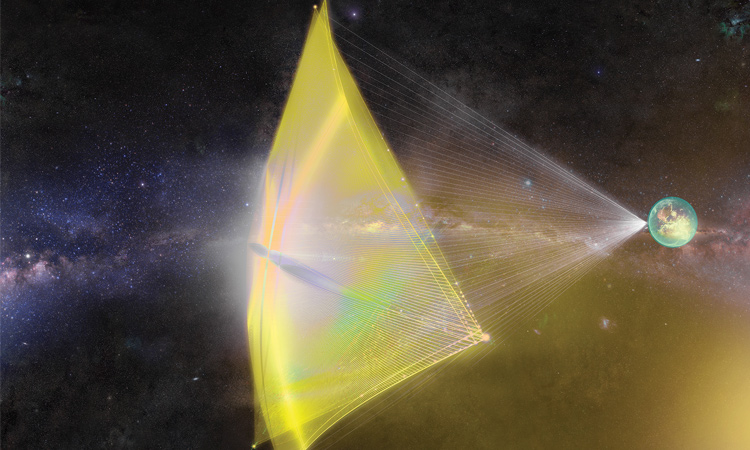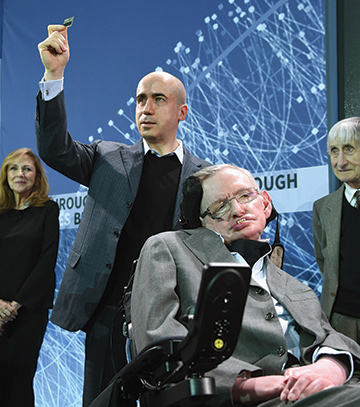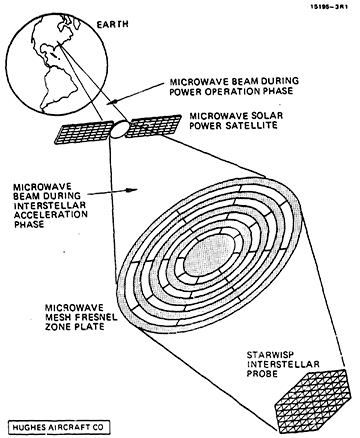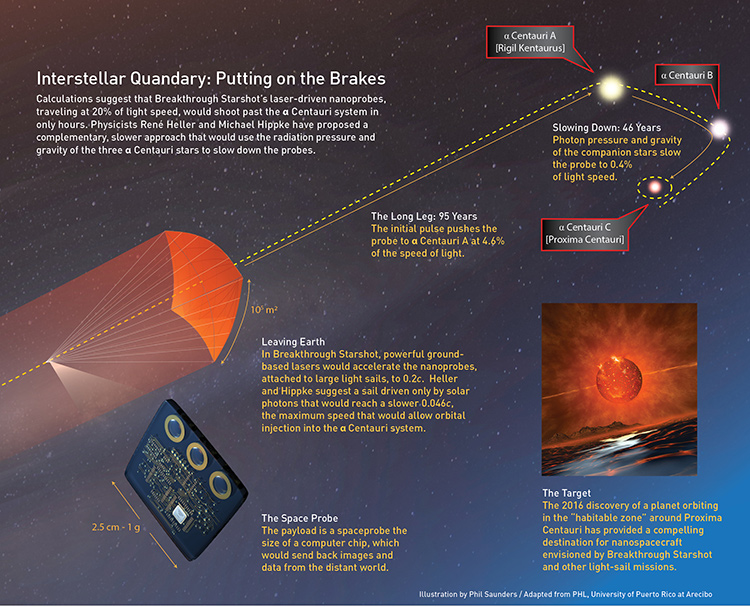 Artist’s conception of a light-sailing spacecraft leaving Earth’s neighborhood. [Illustration by Tatiana Plakhova for Breakthrough Prize Foundation]
Artist’s conception of a light-sailing spacecraft leaving Earth’s neighborhood. [Illustration by Tatiana Plakhova for Breakthrough Prize Foundation]
Traveling among the stars has long been a dream of both science fiction enthusiasts and scientists who study either rocketry or the universe. The daunting distances in both space and time, however, have kept humans planted on their tiny rock orbiting a nondescript sun. Some space enthusiasts now say that the technology required to send eyes and ears to the nearest star system already exists. Thanks to the latest in laser optics, the mission could yield results within a scientist’s lifetime.
Last year, a billionaire assembled a “dream team” of scientists and engineers and gave them a challenge: to design a swarm of tiny spacecraft that would travel to an extrasolar planetary system (at a fairly large fraction of the speed of light) and send back photos and data. To accelerate the miniature space vehicles—which would have a mass of roughly 1 g each—Earthlings would build a phased laser array that would beam gigawatts of energy to the light sails on these tiny spacecraft.
Breakthrough Starshot is one of the several spacefaring initiatives spearheaded by Russian billionaire Yuri Milner and his philanthropy effort, titled Breakthrough Initiatives.
The challenge, dubbed Breakthrough Starshot, is one of the several spacefaring initiatives spearheaded by Russian billionaire Yuri Milner and his philanthropy effort, titled Breakthrough Initiatives. On 12 April 2016, the 55th anniversary of the first human spaceflight, Milner and British physicist Stephen Hawking announced that Milner was putting up US$100 million for conceptual studies of a trip to the stars. (Milner is funding two other futuristic initiatives: Breakthrough Listen, a US$100 million radio survey to detect civilizations beyond Earth; and Breakthrough Message, a US$1 million competition to write a message representing humanity to extraterrestrials.)
The roadmap to the stars proposed by the Breakthrough Initiative challenges sounds both breathtakingly simple and dauntingly complex. Scientists would assemble a “light beamer” operating at a near-infrared wavelength that easily penetrates Earth’s atmosphere. Controllers would steer hundreds or thousands of ultra-low-mass “starchips” or “nanocraft,” equipped with sails only a few hundred atoms thick, into the gigawatt-class beam, which, in seconds or minutes, would propel them to relativistic velocities. The tiny spacecraft would spend 20 years getting to the nearest extrasolar planet and another 4.25 years sending back its data—rather than the hundreds or thousands of years that chemically propelled rockets would require.
 Yuri Milner (left) and Stephen Hawking pose with a chip satellite while announcing Breakthrough Starshot. [Gary Gershoff/WireImage]
Yuri Milner (left) and Stephen Hawking pose with a chip satellite while announcing Breakthrough Starshot. [Gary Gershoff/WireImage]
No one on the steering committee expects Breakthrough Starshot to be easy—or to be accomplished with only Milner’s US$100 million. Every component of the project pushes the limits of technology: the gigawatt-class laser array, the number of sensing and imaging instruments crammed onto each starchip and the communications system for beaming an accurately aimed signal over interstellar distances back to Earth.
Still, some scientists and engineers are eagerly studying the enabling technologies, mostly via numerical simulations, but occasionally through experimentation as well. The 2016 discovery of a planet around Proxima Centauri, the red dwarf star closest to Earth’s Sun, has provided a compelling destination for the Starshot nano-spacecraft. The planet, known as Proxima b, lies within the star’s “habitable zone,” meaning that conditions may be right for the planet to have liquid water on its surface. In February 2017, a Belgium-based team found that another dwarf star, Trappist-1, has several Earth-sized planets within its habitable zone. Obviously, we do not know whether any of these extrasolar planets hosts life, intelligent or otherwise, and the first flotilla of robotic investigators from Earth may not answer the question. Nevertheless, at distances of 4.25 light-years (Proxima b) and 40 light-years (the Trappist-1 planets), these extrasolar systems are close enough to tantalize us.
Origins of the space-sail idea
The notion that light can push corporeal objects dates back four centuries, to Johannes Kepler’s observation that the tails of comets always point away from the Sun. The hypothesis that electromagnetic radiation has momentum, and therefore generates pressure, gained credence with James Clerk Maxwell’s equations in the 19th century as well as experiments performed at the dawn of the 20th century.
 Diagram of the Starwisp microwave-propulsion concept, written by Robert L. Forward. [U.S. Defense Technical Information Center]
Diagram of the Starwisp microwave-propulsion concept, written by Robert L. Forward. [U.S. Defense Technical Information Center]
In the 1960s, science fiction authors Arthur C. Clarke and Robert L. Forward penned stories of solar-sail races in outer space. Forward, a physicist who died in 2002, also published technical studies of potential technologies for interplanetary and interstellar travel, including laser propulsion.
In 1985, Forward drew up plans for Starwisp, a hypothetical low-mass spacecraft pushed along by a microwave beam. Starwisp had several technical difficulties, including the unwieldy size of the craft’s sail, due to the 3-mm wavelength of the beam. In the late 1990s, Geoffrey Landis of the U.S. National Aeronautics and Space Administration (NASA) Glenn Research Center revisited Starwisp in a study for the NASA Institute for Advanced Concepts (NIAC; now known as NASA Innovative Advanced Concepts), the space agency’s program for ideas more far-flung than those in its annual budget request. Landis suggested that a dielectric film, like a carbon mesh, would perform better as an interstellar sail than the aluminum in Forward’s original proposition.
Between these efforts and work happening at the University of California, Santa Barbara (UCSB), USA, a community of interstellar dreamers was—like stars—beginning to align. Practical scientific research, however, requires funding.
Defining the roadmap to interstellar flight
In the spring of 2015, Milner and astrophysicist Pete Worden, who had just stepped down as director of NASA Ames Research Center to become director of Breakthrough Initiatives, approached Avi Loeb, chair of the astronomy department at Harvard University, USA, about joining the Starshot team. Though Loeb is now a theoretical cosmologist, during his doctoral work in plasma physics he led a study of high-velocity acceleration of objects with funding from the U.S. Department of Defense Strategic Defense Initiative (now the Ballistic Missile Defense Organization). “So my background is very much in tune with the nature of this project,” he says.
The work of Philip M. Lubin, a UCSB physics professor, caught Loeb’s attention in late December 2015. Loeb says Lubin has taken Forward’s ideas from half a century ago and put them into the context of modern technology by taking into account the miniaturization of electronics, the many advancements in laser-array science and the significant drop in the cost of lasers.
Lubin and his UCSB Experimental Cosmology Group colleagues started exploring the concept of directed energy in 2009, mostly to defend Earth from wayward meteorites and asteroids. He soon realized that the same kind of large-scale solid-state laser array that would emit a beam powerful enough to deflect a moving space rock would have other potential uses, such as mitigation of space debris, composition analysis of solar system bodies—and relativistic propulsion. Lubin has not yet received funding from Starshot’s parent organization but has been pursuing his Directed Energy Propulsion for Interstellar Exploration (DEEP-IN) research thanks to NIAC and California funding sources.
In his 73-page-long “Roadmap to Interstellar Travel,” Lubin states his view of the essential components of a mission to Proxima b as follows: a “photon driver” or phased array of lasers; a wafer-scale and highly integrated spacecraft-on-a-chip, which could be manufactured by the thousands; and gossamer-thin light sails, one for each craft. It strongly resembles the conceptual framework outlined on Breakthrough Starshot’s own website.
The launch and the journey
For the laser array that will launch the starchips on their journey, the biggest decision will be whether to build it on the ground or in low Earth orbit. The latter option would increase flexibility but would vastly inflate the overall mission cost. A ground-based laser array would require adaptive optics to overcome atmospheric turbulence, and it would have to operate at a wavelength at which Earth’s atmosphere is transparent—in many of his calculations, Lubin suggests 1060 nm. He says that the Breakthrough Starshot panel prefers a ground-based approach to keep the costs of the interstellar mission down, but some of the other applications of the technology would require smaller arrays that could fly in space.
One can imagine a row of starchips, lined up like jetliners awaiting permission to land at an airport, ready to move into position for their photonic push.
The cost of putting the light-beaming array in Earth orbit or the far side of the Moon—hundreds of billions or even trillions of U.S. dollars—would be prohibitive, argues Pete Klupar, another NASA alumnus who serves as engineering director for Breakthrough Starshot. Keeping the array on the ground would keep the cost to the low tens of billions of dollars, similar to CERN’s Large Hadron Collider or NASA’s James Webb Space Telescope.
For their preliminary system work, Lubin and his team are using the master oscillator power-amplifier topology, which would scale up the beam’s power while preserving coherence. “It has to be coherent, otherwise it won’t work,” Lubin says. “You can’t just take a large number of laser pointers and point it at the spacecraft. It’s not going to work.”
Photon recycling—treating the space between the beaming array and the starchip sails as a giant optical cavity to take advantage of multiple photon reflections—could improve the photon drive’s efficiency somewhat at shorter distances, but the diffraction and relativistic effects would cancel it out at longer distances.
The Starshot beam will need to be diffraction-limited out to about 2 million km, according to Loeb. Lubin’s preliminary calculations indicate that a 100-GW phased laser array 10 km on a side could accelerate each starchip spacecraft to 0.2c (20 percent of the speed of light) by firing for roughly three minutes. One can imagine a row of starchips, lined up like jetliners awaiting permission to land at an airport, ready to move into position for their photonic push.
Whatever shape the starchips’ sails take, they must consist of material that is extremely strong, very lightweight and highly reflective. According to Loeb, 99.999 percent of the laser light impinging on the spacecraft sail must be reflected, or else it will burn the sail. Lubin’s roadmap postulates that multilayer dielectric coatings could make the sail sufficiently reflective. Whether the sail could be made of graphene or some other ultrathin, high-tech material is an open question. Klupar suggests that research along the lines of plasmonic nanostructures, metasurfaces and two-dimensional materials, conducted by Harry Atwater’s group at the California Institute of Technology, USA, could eventually provide answers.
Managing the beam-sail interaction will be a huge challenge, according to Jonathan McDowell, of the Harvard-Smithsonian Center for Astrophysics, USA, who is not involved in Starshot or DEEP-IN. Some early solar sails have experienced tears and tangles under the weak radiation pressure of the Sun, never mind a blast of directed energy.
“It doesn’t take much of a wrinkle in the sail for that momentum and energy to not go where it should,” says McDowell, who tracks space debris and satellite orbits. “So if the sail isn’t perfectly stretched taut, instabilities will tear it apart.”
Recently Loeb and a Harvard engineering postdoctoral fellow, Zac Manchester, calculated how the shape of the starchips’ sails would interact with the beam from the laser array. During the all-important acceleration phase, each spacecraft needs to be centered on the beam. The Harvard pair reexamined a previously simulated case of a conical sail in a microwave beam and found that such a sail would be unstable in a directed energy beam without active feedback control or other stabilizing mechanisms that would add mass and complexity to each craft. Their three-dimensional ray-tracing simulations showed that a spherical shell shape would give the sail enough passive stability to ride a beam with a hollow or multimodal (rather than Gaussian) profile.
Squeezing every instrument needed for an interstellar trip into a gram-scale package may seem daunting, but as Starshot researchers point out, recent advances in silicon photonics should allow designers to place phased-array communications lasers, imagers, accelerometers, gyroscopes and other microelectromechanical-system devices in a single wafer. Loeb believes that getting the starchips down to a gram or so is eminently realistic, because even today the guts of a smartphone weigh only a few grams—everything else is battery power, user interfacing and packaging.
As a crowdfunded proof of concept, Manchester and his former doctoral adviser, Mason Peck of Cornell University, USA, built several hundred wafer-sized satellites and launched them into orbit aboard a NASA CubeSat (small satellite payloads built by universities, high schools and non-profit organizations and set to fly on upcoming launches). The outer packaging was unable to release the tiny “beepsats,” but many of its supporters could still detect the personalized radio signals from “their” craft.
Another challenge for the nano-spacecraft will be withstanding the gas and dust encountered along the way. The space between stars in the Milky Way may look empty, but it’s not—the interstellar medium (ISM) consists of ionic, atomic and molecular gas, as well as dust grains finer than smoke particles. Though extremely tenuous compared with Earth’s atmosphere, the ISM could conceivably exert drag on a sail moving at relativistic speed, and the impacts of gas and dust particles could cumulatively erode the starchips’ outer surfaces—or even send the ships careening off course.
Researchers at NASA Ames and the Korea Advanced Institute of Science and Technology recently suggested that a silicon chip design employing an experimental type of nanowire transistor would have “self-healing” capabilities that could protect the starchips’ tiny instruments against cumulative radiation damage over their 20-year journey.
Arriving and returning data
When the starchips eventually arrive at Proxima Centauri or any other planetary system, they would be whizzing along at 0.2c. At that speed, the spacecraft would cover the equivalent of the Earth-Moon distance in a mere 6 seconds or the Earth-Sun distance in 42 minutes—not much time to perform observations after so many years of waiting. To convert a quick flyby into an extended mission, the starchips would need to decelerate without firing retrorockets, which again would require a heavy fuel payload.
Two German scientists, René Heller and Michael Hippke, recently calculated that the maximum “injection speed” at which a small satellite could be captured in orbit around Proxima b would be 0.046c. That scenario assumes a sail with the same mass-to-surface ratio as graphene and a 10-g payload—significantly larger than the Breakthrough Starshot concept. To brake itself, each starchip would swoop through the gravitational fields of the three Alpha Centauri stars, settling into a highly elliptical orbit around Proxima Centauri and, perhaps, just Proxima b (see infographic below).

Lubin says the paper by Heller and Hippke is well done. However, for his own simulations, he has rejected monolayer graphene as a sail material because it won’t work at the faster relativistic speeds for which he is aiming, and no one yet knows how to make graphene reflective. “It is definitely something for the future to ponder as materials get better,” he says.
The interstellar mission won’t mean anything to humans if none of the starchips can send their data and images back home.
The interstellar mission won’t mean anything to humans if none of the starchips can send their data and images back home. Recent advances in space-based optical laser communications have made Starshot researchers reasonably confident that an onboard laser with a few watts of power could be heard all the way from Proxima Centauri. The communications signals would be faint, but the phased laser array could double as a giant receiver. The narrow-band signal would be distinguishable from other sky sources, Harvard’s McDowell says, though he still sees data reception as one of the larger technical challenges of Starshot.
The human side of the interstellar quest
As one might expect from an audacious, envelope-pushing project, Breakthrough Starshot has its share of skeptics and detractors. Even Lord Martin Rees, Great Britain’s Astronomer Royal, admits to doubts about Starshot’s feasibility. Rees, who leads the advisory committee for Breakthrough Listen, Milner’s companion search for extraterrestrial intelligence, thinks Starshot is the more speculative of the two projects.
Answering questions at an American Physical Society lecture in January, Rees said that it might be more worthwhile in future decades to spend the US$10 billion on an array of huge orbiting telescopes to observe planets directly. Yet he found one slight upside to Starshot: a laser array that could propel the starchips to 0.2c might have enough power to be seen at the farthest reaches of the observable universe—Earth’s beacon for other civilizations if they exist.
McDowell is also skeptical that relativistic interstellar travel is achievable in his lifetime. However, the Starshot research easily could revolutionize flight within our solar system, so he sees it as a worthwhile endeavor. If small robotic probes could reach Mars in a few days and the outer planets in a couple of weeks, rather than multiple years, it would open up the entire solar system to the fertile minds of young investigators on a budget.
Starshot has sparked the imagination of at least one member of the U.S. Congress. In May 2016, Rep. John Culberson, who represents part of Houston—the large Texas city that’s home to NASA Johnson Space Center—directed the U.S. space agency to start drawing up a conceptual plan for interstellar travel, whether by directed laser energy, nuclear fusion or a ramjet that would scoop up hydrogen from the ISM. Culberson’s goal is to launch an interstellar mission in 2069, the 100th anniversary of the Apollo 11 mission to the Moon.
Klupar includes optical scientists and engineers among the professionals he would like to attract to the Breakthrough Starshot brain trust. Later this year, his foundation will issue formal requests for proposals for small (perhaps US$5 million) conceptual studies. Klupar expects that ground-based prototyping and experimentation could start five years from now, with a test array capable of solar-system travel under construction in the early to mid-2030s. “I don’t think we know enough to truly understand what the final system is going to be like,” Klupar says. No one in the late 1940s could have envisioned the details of NASA’s Apollo program two decades later.
The foundation’s website (https://breakthroughinitiatives.org) includes bibliographies and online discussion forums for each of the key technical challenges, from laser communications with Earth to collisions with objects in space. Anyone can sign up for a spot in the conversation.
Ultimately, the trip to the stars must be a global effort, says Klupar, noting, “If we can’t get the governments of the world to act as participants, then we’re lost.” Not only will a true “starshot” cost more than any one nation can afford, but society cannot afford the potential conflict if one or more countries sees the light beamer as a possible weapon instead of a transportation system. Any mission to an extrasolar planet will have to be on behalf of—and a benefit to—all of Earth’s humanity.
Patricia Daukantas is a freelance writer specializing in optics and photonics.
References and Resources
-
G. Anglada-Escudé et al. “A terrestrial planet candidate in a temperate orbit around Proxima Centauri,” Nature 536, 437 (2016).
-
D. Clery. “U.S. lawmaker orders NASA to plan for trip to Alpha Centauri by 100th anniversary of moon landing,” Science, DOI: 10.1126/science.aag0558 (2016).
-
D. Cornwell. “Space-based laser communications break threshold,” Opt. Photon. News 26(5), 24 (May 2016).
-
P. Lubin. “A roadmap to interstellar flight,” J. British Interplanetary Soc. 49, 40 (2016).
-
R. Heller and M. Hippke. “Deceleration of high-velocity interstellar photon sails into bound orbits at α Centauri,” Astrophys. J. Lett. 835, L32 (2017).
-
Z. Manchester and A. Loeb. “Stability of a light sail riding on a laser beam,” Astrophys. J. Lett. 837, 2 (2017).
-
R. Stevenson. “Self-healing transistors for chip-scale starships,” IEEE Spectrum 54, 2 January 2017.
-
M. Gillon. et al. “Seven temperate terrestrial planets around the nearby ultracool dwarf star TRAPPIST-1,” Nature 542, 7642 (2017).
